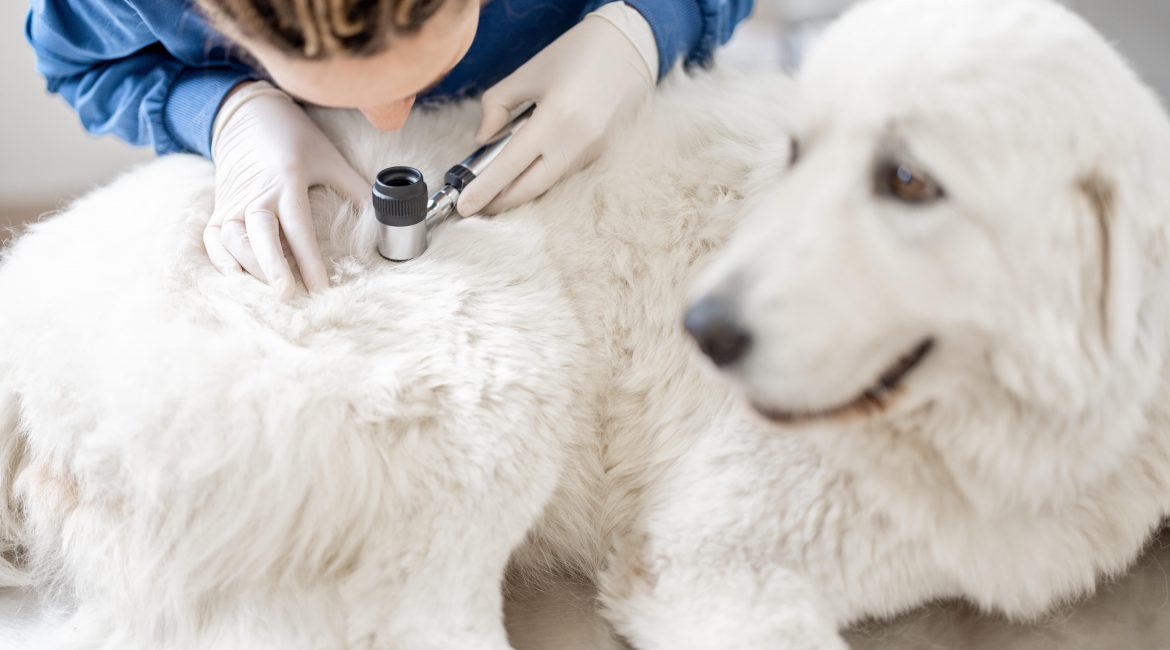If your vet has diagnosed your pet with skin cancer or if you are concerned about the risks of skin cancer in dogs, then, as a responsible paw parent, it’s important for you to know these facts on the condition.
Did you know that between 60 and 80% of the skin tumours found on our precious pooches are benign (not harmful or cancerous)?
This means that if you notice a lump on your pet’s skin, the chances of it being dangerous to your dog’s health are low. But this doesn’t mean you shouldn’t get it checked out by your vet.
Here’s what you need to know about skin cancer in dogs…
What causes skin cancer in dogs?
Dogs who have light coloured skin or a thin coat have the highest risk of skin cancer caused by sun exposure.
Sun exposure
The sun is one of the main causes of skin cancer in dogs. However, not all cases are related to the sun. If your dog has light skin, a thin coat, or lacks fur, then they have a high risk of skin cancer from the sun, especially if they have suffered from sunburn at some point in their life.
How do I know if my dog is sunburnt?
Sunburn can result in reddened skin and in some cases, hair loss.
The commonly affected areas include:
- The bridge of the nose
- The belly
- The inner side of the legs
- The skin around the lip
- The tips of the ears
- And any other areas of light pigmentation.
What can I do to protect my dog from the sun?
It can be tricky to shield your dog from the sun all the time. If you can, try to limit your dog’s sun exposure between the times of 10am and 3pm as this is when the sun is at its hottest.
You can also use a special sunscreen to protect your dog’s skin. Make sure you use a sunblock that is safe for dogs and free from ingredients like zinc (found in most sun creams) which can be very harmful to dogs.
Excessive licking
Some experts suggest that excessive licking of certain areas or a particular spot can increase the likelihood of a cell multiplying. This means that the chances of the cells mutating and becoming cancerous are increased.
Genetics
Some dogs are genetically predisposed to cancer.
How do I know if my dog has skin cancer?
The symptoms of skin cancer can vary. Typical signs of skin cancer in dogs include:
- Lesions
- Scabs
- Unusual bumps on the skin
- Lumps
These lumps, bumps, and lesions may be grey, pink, red, brown, or black in colour. Keep an eye out for any strange and unusual bumps and lumps on your dog’s skin. If you find anything strange, book an appointment with your vet to determine whether or not the lump is cancerous.
Tell me more about the different types of skin cancer in dogs
Malignant melanoma
This type of skin cancer develops in the melanocytes. These are the pigment-producing cells in the skin. Malignant melanoma is typically found in the mucous membranes like the nose and mouth. In some rare cases, it can also develop under fur.
Malignant melanoma can easily grow and spread to the lymph nodes and other organs. In humans, this type of cancer is usually a result of sun exposure. However, the cause of it in dogs is a little unclear. Experts suggest that genetics may have a role to play.
Mast cell tumours
These skin cancers develop in the mast cells of your dog’s immune system and are the most common skin tumours in dogs. Vets do not know the exact cause of mast cell tumours, however, there are cases where this type of cancer has been linked to irritants or inflammation on your dog’s skin.
There is some evidence that suggests that genetic factors also play a role.
Squamous cell carcinoma
This form of skin cancer in dogs is often a result of sun exposure. Experts believe there is a link between the development of this cancer and the papillomavirus. Squamous cell cancers will not spread to any surrounding lymph nodes. They are, however, extremely aggressive in that they cause a large amount of damage to tissue around the tumour.
How will my vet diagnose skin cancer in my dog?
If your vet thinks that your dog may have skin cancer, then he or she will use a fine needle to conduct a biopsy. This simple procedure removes some of the tiny cells in the tumour, which allows for your vet to examine them using a microscope and determine whether or not they are cancerous.
In some cases, a sample cannot give a good enough diagnosis. If this is the case, then your vet might perform surgical removal of the tumour.
How to treat skin cancer in dogs
Thanks to advances in pet healthcare, the majority of skin cancers can be successfully treated. In most cases, your vet will remove the lump from our dog’s skin. Your vet may also suggest chemotherapy or radiation if he or she cannot remove the entire lump or tumour.
Pet insurance and cancer in dogs
With Oneplan Pet Insurance, we will insure your dog who has cancer, or any other pre-existing, congenital, or hereditary condition for that matter (you can read more about that here). However, if your dog showed symptoms of the cancer before your cover began (meaning it is a pre-existing condition), you will have to wait twelve (12) months before you can claim for any events relating to the treatment of cancer. Once this waiting period is over, your vet bills relating to cancer are covered.
We also don’t limit you when it comes to vet networks, meaning you can continue to visit your favourite vet who understands your pet and knows their medical history.
It’s always best to insure the health of your pet as early on as possible so they can get the best care possible for unexpected illnesses such as skin cancer.
Your Pet Insurance Family,
Oneplan




